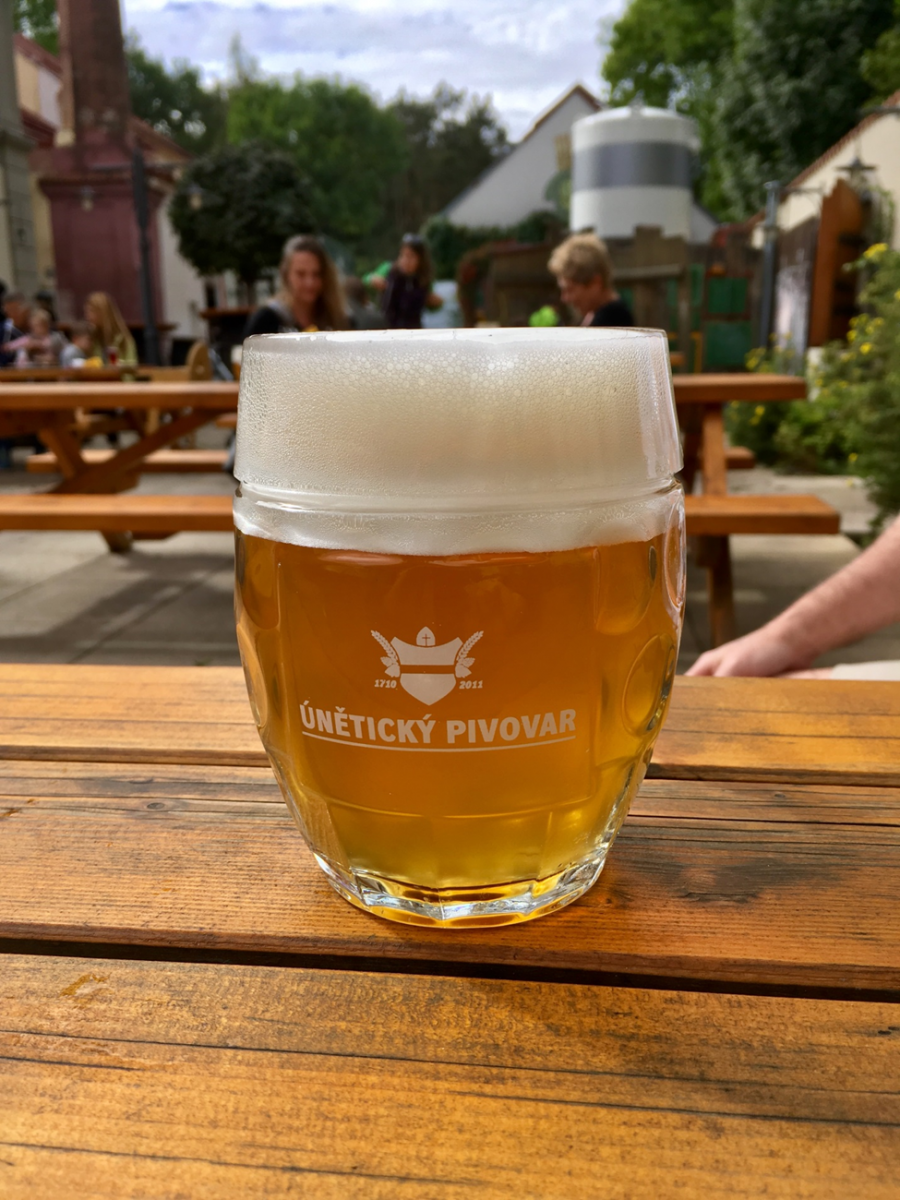A beer drinker’s tale of visiting the Czech Republic
02/04/2021
Prologue
In the early summer of 2019 my wife (Kathleen) suggested we take a trip to Europe. I immediately yelled out: Prague! I have wanted to visit Prague for well over a decade. For its beautiful scenery but mostly because of beer!
I have been homebrewing for over 25 years and I brewed my first batch of Bohemian Pilsner (Czech Pale Lager) in 1998 and that batch turned out pretty darn good. Not a homerun by any means but tasty enough that this was a beer style I would want to brew over (and over) again. Since 1998 I have annually brewed a batch of Bohemian Pilsner which makes my latest batch, batch number 23.
Back in my early homebrew days for me Czech beer = Bohemian Pilsner. It was not until much later in my homebrewing hobby that I learned there was much more to Czech beer besides Bohemian Pilsners and that they also brewed dark lagers as well. In the September/October 2013 issue of Zymurgy magazine there was an article entitled “Czech Dark Lager”. This article was a revelation for me and I just had to learn more. Via a web search I found a Brewers Association article, “Style Spotlight: Bohemian Dunkel” and at this point I was hooked: I just had to brew a beer like this. Between the two articles I formulated my own recipe. I figured that my first batch of 2013 would be a good initial effort and I could progress and tweak from there. To my pleasant surprise this first batch turned out great – a homerun out of the gate! The Czech beer gods must have been smiling on me. Ever since, I have annually brewed a Czech Dark Lager to that exact same recipe.
So, we made our plans in that early summer to visit Prague (and the Czech Republic). We would go in late summer/early fall to avoid the heat and the large tourist crowds that can occur during the summer.
The Czechs love their beer!
It is common for some folks to think that the Germans drink the most beer but that is not the case. The Czechs drink the most beer per capita of any nation. From The Telegraph newspaper: “The world's biggest beer drinkers · Czech Republic - 143.3 litres per capita · Namibia - 108 · Austria - 106 · Germany - 104.2 · Poland - 100.8”.
Well, I did not expect Namibia to be in the top five. Cheers to the Namibians!
The other aspect of the Czechs is that they like to socially drink and pubs are everywhere to support beer drinking conviviality. I just knew that the Czech Republic is the place for me. One other aspect worth noting is that for a variety of circumstances Prague by large margin was unscathed during World War II so there is a lot of old, beautiful architecture for sightseeing. One example is the Prague Castle but there are lots more sights beyond that which are must see sights.
The birthplace of Pale Lager
The most popular type of beer consumed worldwide is Pale Lager, and these sorts of beers all started in the town of Pilsen in 1842. Pilsen is located in the western part of the Czech Republic. It all started with bad beer:
The first (original) Pilsner was brewed in 1842 by the Bavarian brewer Josef Groll who traveled to the town of Pilsen to help the locals brew a better beer. The lore is that the citizens of Pilsen were unhappy with the quality of their existing beers and that by bringing in an experienced brewer they could change things. And Josef Groll did indeed change things.
Bavarian lagers were historically dark, but Groll created a new pale lager in Pilsen. He achieved the lighter color by kilning the malt at a lower temperature, a technique he and other Continental brewers borrowed from Great Britain. Today we call this ultra-pale malt Pilsner malt.
Another distinguishing feature of the new beer is that it was brewed using locally grown Saaz hops and very soft water, i.e. very low in dissolved minerals. The resulting beer became a hit, and we know that beer today as Pilsner Urquell (Urquell is German for “original source”). Pilsner Urquell is marketed as “The Original Pilsner.”
Application of the term innovation to beer is popularly debated, but the development of Pilsner Urquell was indeed an innovation, one which would have major repercussions for brewing in the 19th century and beyond.
How to talk beer like a Czech
You really do not have to speak Czech while visiting the Czech Republic. All of the younger Czechs (e.g., under the age of 30) speak English very well since English is taught to them at a young age in school. In Prague most of the older folks (over the age of 50) also speak English since it is a tourist town. Older people outside of Prague may not be English speakers.
But I like to learn Czech beer words and you might too. Basically the Czechs describe their beers by color and strength. First, let’s learn our colors:
-
Pale = Světlé
-
Semi-dark (Amber) = Polotmavý
-
Dark = Tmavý (or Tmavé)
-
Black = Černý
When it comes to beer strength, what we would typically associate with alcohol (ABV) strength, the Czechs instead describe the original gravity of the wort used to brew the beer. They have words for this but more commonly I have seen numbers in degrees Plato to describe the beers strength. In order of lower to higher strength:
-
10° or Výčepní
-
12° or Ležák
-
14° or Speciál (or Speziál)
You may on occasion see some values other than those listed above (e.g., 11°, 13°, …) but you get the general idea.
I will discuss my tour/visit to Únětický Pivovar (Pivovar = Brewery) later but here is an example of a Czech beer menu for that place (note the differing sizes of 0.3 and 0.5 liters):

This brewery only served Pale Lagers so you only had to specify which degrees (e.g., 12°) you desired. I was told that they did produce a Dark Lager for the Christmas season.
If you want to try out your Czech lessons, a Bohemian Pilsner (or as the BJCP lists it Czech Premium Pale Lager) would be Světlé Ležák.
It is worth noting that within the Czech Republic they consider the term ”Bohemian Pilsner” to be an appellation reserved for the Světlé Ležák that is brewed only in Pilsen. I still use the general terminology of Bohemian Pilsner since that is what homebrewers (BJCP) called these beers when I first started brewing them in 1998 and needless to say I am not a Czech citizen.
If you just want to say beer in Czech it is pivo. And one thing my wife and I always did upon drinking our first beers at the pub was to lift our glasses and proclaim “Na Zdravi” which means cheers. I did not ever witness the Czechs in the pub do this but they did not give us dirty looks when we did it; just trying our best to fit in.
Let’s visit some Pubs
U Fleků
The brewery/brewpub of U Fleků was founded in 1499 and they claim to be the world’s oldest brewpub. Let’s start our pub journey with the oldest.
They only serve one type of beer at U Fleků and it is a Czech Dark Lager (Tmavý Ležák) and for some reason they serve it in 0.4 liter mugs (the typical draft glasses in the Czech Republic are 0.5 liters and 0.3 liters):
Now, don’t let the size of that head get you in a tizzy, The bartenders in the Czech Republic are very experienced in providing proper beer amounts and the beer glasses are extra sized to provide room for a good head of foam.
U Fleků has an idyllic beer garden with communal seating to foster a friendly atmosphere and an enjoyable beer drinking experience. My wife and I visited U Fleku three times during our two weeks stay. The beer was excellent, the food was very good (smoked sausage for me) and we enjoyed the live music (e.g., accordion players) and ambiance.

U Buldoka
A pub that is also a bit of a sports bar was just a few blocks from our hotel. I thought it would be interesting to see how the locals enjoy their sports. Needless to say soccer was the sport being shown on the several TVs in the bar. I am not a big soccer fan but they did have beer here so I was a happy camper. This pub was a Tankovna (Tank Pub) which means that they served beer (Pilsner Urquell) out of tanks within the pub. These beers are unpasteurized so one less step of processing for these specific beers. I did indeed have a 0.5 liter glass of Pilsner Urquell but I noticed that on the menu they had their version of a Half & Half which is half Pilsner Urquell and half Velkopopovický Kozel Černý. This was a tasty blend of beers and a highlight for me for this pub visit.
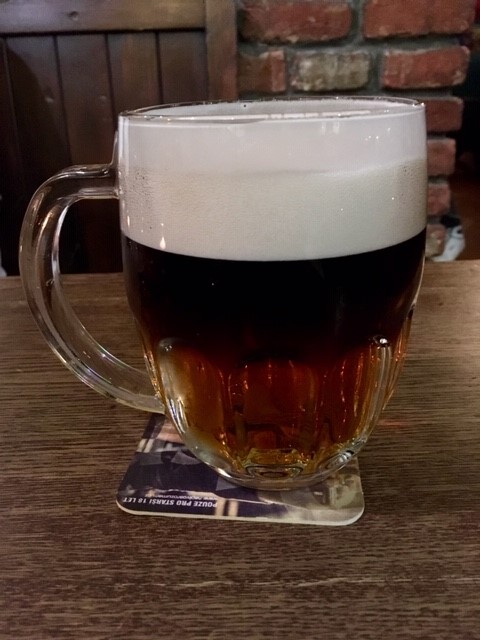
The above beer motivated me when I came home to drink a blend of my homebrewed Bohemian Pilsner and Tmavý Ležák. While I enjoyed drinking that blended beer I am sad to report that I was unable to achieve the appearance of the above pictured beer. Those Czech bartenders really know their stuff.
Below is a photo of tanks at a differing pub which contained unpasteurized Pilsner Urquell:

Zlý Časy (Bad Times)
While U Buldoka was an easy stroll from our hotel our next pub visit was more of an adventure. Prague has an excellent public transportation system of subways, trams and buses. We mostly took the trams and for this next pub visit we had to transfer from one tram to another. We got off at the right stop but we had to walk around quite a bit before we found the location. I suppose it was too tucked away for us?
The bar area of this pub is downstairs and has a cool, dungeon feel to it. As noted in the title above this pub is named Bad Times which I suppose is illustrated by the clock above the bar (can you guess what time we were there?):
In the below photo hopefully you can obtain some of the feel/ambiance of this pub:
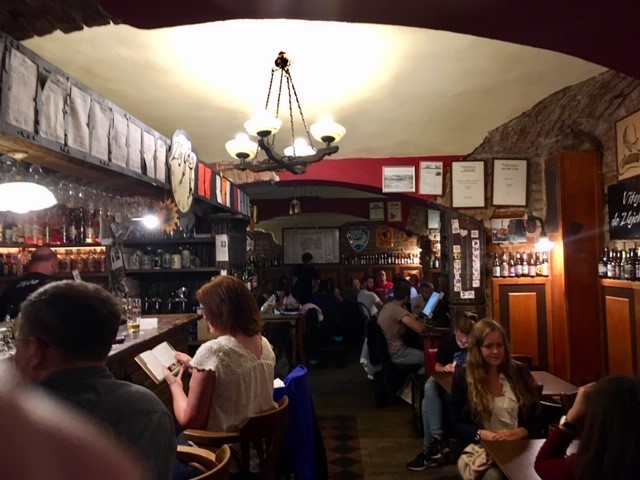
For beer I drank several 0.5 liter glasses:
I had two pours of Únětické Pivo 12° (a Bohemian Pilsner) which I really enjoyed. This pub visit planted a desire in my mind to visit this brewery at some point in our trip.
I also had one glass of Matuška Tmavé Speciál which was a very intriguing and enjoyable beer – it had a very complex flavor profile. This beer is described on the brewery’s website (English translation via an online translator) as:
“DARK
Our dark is more hopped than is common in this species. It is also not sweetened.
Enjoy a mix of roasted malts with pleasant bitterness. Our Czech brewery terminology does not know the term “black beer”, therefore we mention dark with a dash of black. According to the analysis of the color of our dark, however, falls into the category of Schwarzbier, which is in the world commonly recognized.
style Schwarz
stupňovitost 14 °
alcohol 5.8%
BITTERNESS 35 IBU
MALT Pilsner, Munich, caramel, roasted (colored), Carapils, barley
HOP Saaz Special
FERMENTATION lower
AVAILABILITY frequent”
Prague Beer Museum
The aspect of “museum” is a misnomer in that this place is just a pub (which is A-OK with me). In Prague there are two locations and we visited both of them because, well you know one pub is not enough.

One of our visits just happened to be on a Czech holiday:
“This holiday is always celebrated on September 28th. It is the feast day of St. Wenceslas, the patron saint of Bohemia, and commemorates his death in 935. Also known as 'Czech Statehood day', it is a national holiday in the Czech Republic and has been a public holiday since 2000.”
It just seemed appropriate to visit a beer museum on a Czech National Holiday and I did enjoy celebrating by going ‘dark’ for the day.
My first beer was a 0.5 liter glass of Bernard Tmavý Ležák (Dark Lager) which has an ABV of 5.1%:
I thought this beer was very, very good! This beer very much reminded me of my homebrewed Tmavý Ležák.
Our second beer was labeled/branded as being a Porter but it really is a high gravity dark lager as listed on the beer menu: “Tmavý Ležák/Dark Lager/19°/8 % ABV”.
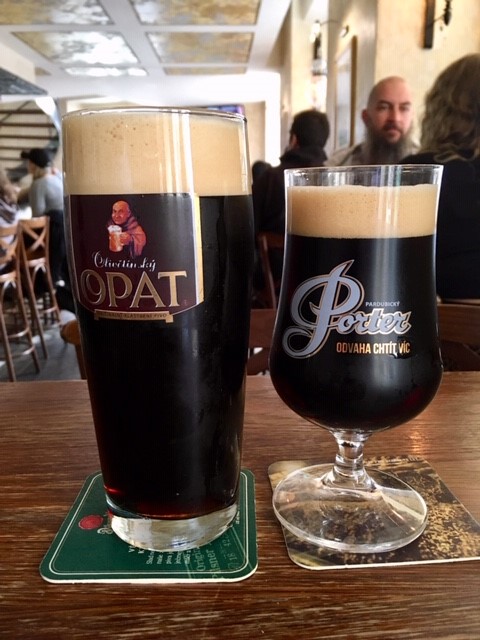
This beer was extremely tasty. There were plenty of dark fruit flavors and this beer almost reminded me of a Quad.
Na Zdravi to St. Wenceslaus!
Outdoor drinking - Open Air Market (Farmers Market) on the banks of the Vltava River
Every Saturday morning during our visit there was an open air market on the riverbanks of the Vltava River (which bisects Prague). After we ate breakfast we went for a stroll to see the sights (and of course drink beer). I was amazed to see that even the riverside venues served Tankovna beer:
We decided to enjoy a couple of glasses of Bernard 11° Pilsner on the back end of a boat:
That beer was very good! Between this beer and the Bernard Tmavy Lezak I had at the Prague Beer Museum I have reached the conclusion that Bernard makes very good beer. Na Zdravi to Bernard Brewery.
And beyond the beer there is lots of good food (pastries, bread, sausages, etc.) available from the numerous tents at the open air market. A very nice way to spend a Saturday morning/afternoon.
Let’s visit some breweries
Pilsner Urquell Brewery (Plzeňský Prazdroj)
Before we left for our vacation I had in mind visiting the Pilsner Urquell brewery – the birthplace of the Bohemian Pilsner. It was a fairly short train ride (it took over an hour) to get to Pilsen from Prague but well worth the visit. There is plenty of good sightseening in town but I will concentrate on the brewery tour here.
Firstly, let me state that the tour was very good! The tour took 1 hour and 40 minutes. This tour was on par with the tour given at Sierra Nevada – Mills River, NC.
I also need to caveat that much of the details below are via the tour guide. Our tour guide gave a good tour but she does not have a brewing background; she was hit or miss in answering my many technical brewing questions.
Below are some of my notes I scribbled on a piece of paper:
-
The brewery was constructed from 1839 – 1842
-
When we were being transported in a bus the tour guide pointed to a building where they treat the water (obtained from wells) to soften/demineralize to water for brewing. Later on I asked her what was the Total Dissolved Solids (TDS) of the well water and also the water used for brewing – she did not know the answers here.
-
During the tour of the packaging lines (bottles and cans) she stated the beer was flash pasteurized prior to filling the bottles/cans.
-
The barley they use is grown in Moravia and they malt the barley at the brewery.
-
They reuse the yeast 4 times.
-
She stated the yeast is a single strain. Later in the tour (in the cellars) it was listed on the side of the wood fermenter: “H II” for the yeast used to ferment the cellar beers.
-
They conduct a triple decoction mash and when heating up the wort/grains for decoction they use a high temperature natural gas heating – 600 degrees C. Caramelization occurs here.
The most fascinating portion of the tour for me was going into the cellars where they used to ferment/lager their beers before they modernized in 1992. The stated claim for why they still produce beer the ‘old way’ is as a quality control effort – to ensure that the beers being produced in stainless steel is ‘exactly’ the same as how the beer used to be produced.
They ferment and lager in oak barrels (oak trees from the Czech Republic). The lager oak barrels are lined with pitch so the beer is not in contact with wood during the lagering process. Some of the details for how they brew in the cellars:
-
They ferment in open barrels for something like 10 days (or until the beer is deemed finished).
-
The lager for about 30 days (or until the beer is deemed finished).
-
They ferment and lager at the same temperature: 5 °C (41 °F)

At the end of the tour they pour you a 0.3 liter glass of beer directly from the lagering barrel for you to drink. That beer is unfiltered and unpasteurized and is damn tasty!
We were able to drink this unfiltered and unpasteurized Pilsner Urquell later in the day when eating lunch at the nearby Na Parkanu Pub:
.png)
Staropramen Brewery
One of the tag lines that Staropramen Brewery uses is that it is the largest brewery in Prague. And it just so happens the hotel we were staying at was on the same block as the brewery and looking from our window we could be the distribution portion of the brewery: loading dock with lots of kegs stacked up.
My wife and I took a tour of the Staropramen Brewery (it was a 3 minute walk from our hotel). Before the tour my wife asked: Are you going to ask a bunch (of annoying) questions during the tour? She didn’t actually say the words “annoying” but via the tone I got the ‘message’. My response to her question was: absolutely!!
The tour was ‘interesting’ in that it was a multimedia tour vs. an actual tour of the brewery with a tour guide. I almost felt like the folks who took a ‘tour’ of Jurassic Park in the beginning of the movie where that tour was movies with narration. Needless to say it was a disappointment for me since I couldn’t ask my (‘annoying’) brewing questions.
An option with the tour was a beer tasting after the tour and of course we chose to do this. There is a very nice pub in the basement of the Staropramen Visitor Center of the brewery and we were served four sample pours (see photo below). From right to left the four beers were:

· Staropramen Premium: what I would term a Bohemian Pilsner but the Czechs would term as a Pale Lager
· Unfiltered: brewed with malt (Pilsner Malt I presume) and wheat and unfiltered
· Granat: they term this beer as being a semi-dark beer and brewed with three malts including caramel malt
· Dark Lager (Tmavý Ležák): brewed with 4 malts and I presume one is caramel malt based upon my tasting of this beer
Both my wife and I preferred the Pale beers over the non-Pale beers.
The Granat beer is marketed by Staropramen as being brewed using a recipe from 1884. From the Staropramen website:
“Staropramen Granat is a unique lager which proudly embodies our brewing traditions. This beer is based on the original recipe from 1884. The special sprinkling process of mixing pale and specialty malts is what gives the beer its unique ruby red - granat - colour.
Staropramen Granat – fine hops meet a perfect combination of three different malts.”
The Granat reminded me of Yuengling Traditional Lager. It was brewed well but not exactly a favorite of mine.
The Dark Lager (Tmavý Ležák) had too much of a caramel flavor for my liking. My wife’s comment was: this is not nearly as good as the Tmavý Ležák you brew.
In addition to this ‘complementary’ sample pour I also ordered a small (33 cl) pour of their Černý (also a Dark Lager) which was on tap. I enjoyed drinking this beer – it had a more complex flavor profile and the caramel aspect was subtle compared to the other non-Pale beers I discussed above.
Únětický Pivovar – a small wonder
I previously discussed Únětické Pivo 12° when I visited Zlý Časy Pub. I really enjoyed drinking that beer and later in our vacation I convinced my wife to visit and take a tour of the brewery.
On a Sunday morning we traveled to the town of Únětice which is 8 km (about 5 miles) from Prague as the crow flies. It was a 20 minute ride via Uber.
As we got out of the car we were presented with a pretty site:
We took the 12:00 (noon) tour of the brewery. The ‘downside’ is that the tour was conducted in Czech but later on the tour guide (a young fellow who is the assistant brewer there) did answer some questions in English.
The first part of the tour was concerning malt. All of the discussion here was in Czech but I got a chance to see several bags of malt stacked up. As their base malt they use malt from Malthouse Kounice:
-
There were 50 kg bags of Pilsner malt
-
There were 25 kg bags of Munich malt

The next part of the tour was the fermentation room. There are 6 round open fermenters:

The next stop was the lagering room. We saw 8 larger sized lagering tanks (vertical in orientation). There were also a few smaller tanks in there as well. I took notice of a monitoring display on the wall with most of the indicators reading 1 °C but one read 5 °C and one was 2 °C. These were the temperatures of the individual lagering tanks. I asked the tour guide how long they lagered their beers and he stated about 30 days.

The tour guide (assistant brewer) is the young fellow in the plaid shirt.
As the tour was finishing I asked the tour guide another question and after answering he asked me “Are you a brewer?” to which I responded “Yes”. He then asked “Would you like to drink something?” and needless to say I enthusiastically responded “YES!”. He took me back to the lagering tanks and ‘poured’ me a glass of the 10° beer directly from the tank. It was very good! He made mention this beer is solely brewed using Pilsner malt.
As we both drank beer we continued to chat and below is part of that conversation:
-
He worked an internship during the summer at Pilsner Urquell in the recent past
-
Únětický pivovar only produces a dark lager during Christmas time
-
They solely use Saaz pellet hops (T-90)
This tour was great in that it was intimate and small (only four people: my wife and me and two other women) and with a small brewery you get to see everything!
But wait, there’s more:
There is a very nice Beer Garden at the brewery and it was an absolutely idyllic day – pretty blue skies, puffy white clouds, and warm temperatures. We shared a picnic table with Ivan and Marek and had a wonderful conversation as we drank many glasses (0.5 liter) of beer and ate excellent food for lunch (venison stew for me and roast boar for my wife).
Both my wife and I enjoyed three glasses of beer from 10° -> 12° ->14° and I had one more last beer of 10°. Below is a photo of the 10° beer:
Sadly it was mid/late afternoon and time to leave but I just had to get one more beer for the road (which we shared later that evening back in the hotel). As we were standing outside, with me holding a bottle of beer, a passerby commented about me leaving with a beer. I held that beer high and exclaimed “Dobré pivo!” which means good beer. I know a few words in Polish since all of my grandparents emigrated from Poland and luckily the same words for good beer in Polish are exactly the same pronunciation for the Czech language.
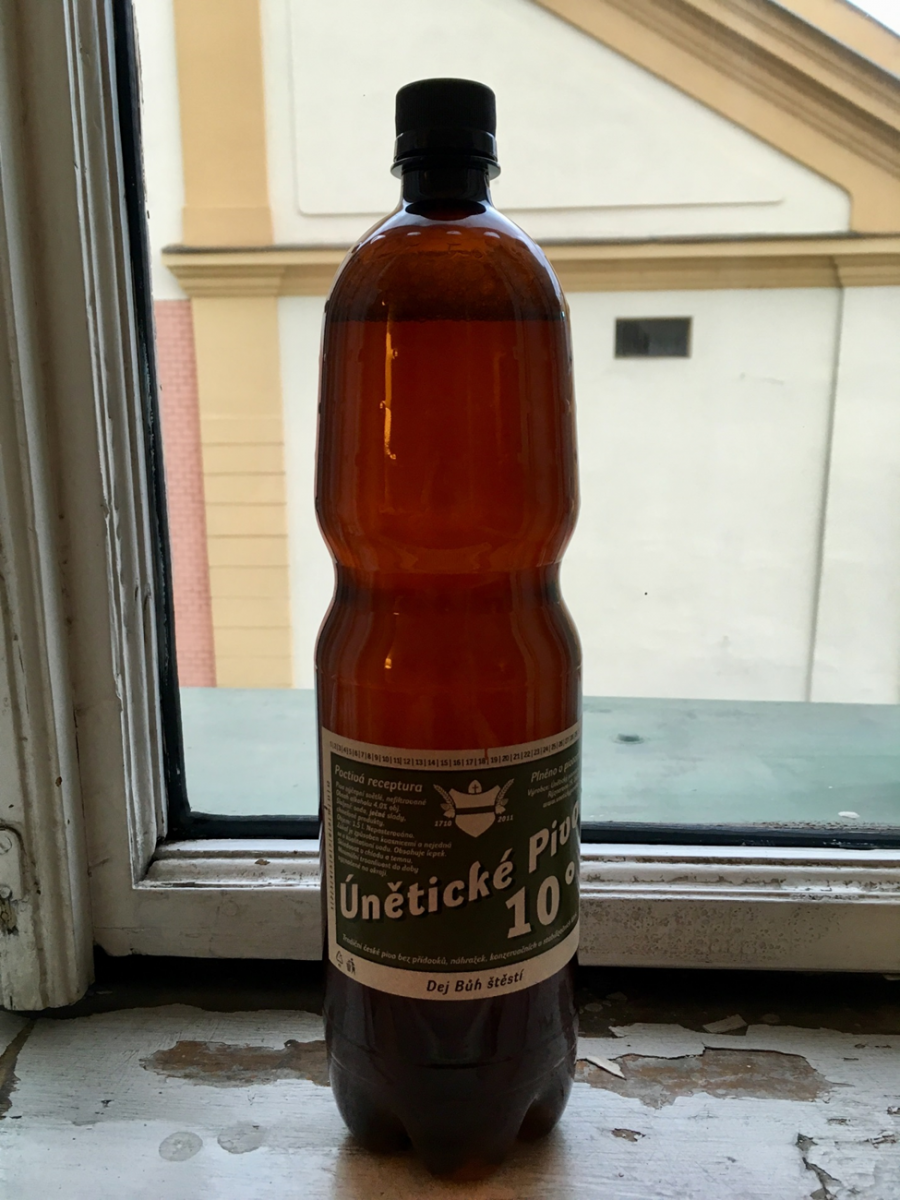
My last Únětické beer
Na Zdravi to visiting the Czech Republic!
All contents copyright 2024 by MoreFlavor Inc. All rights reserved. No part of this document or the related files may be reproduced or transmitted in any form, by any means (electronic, photocopying, recording, or otherwise) without the prior written permission of the publisher.











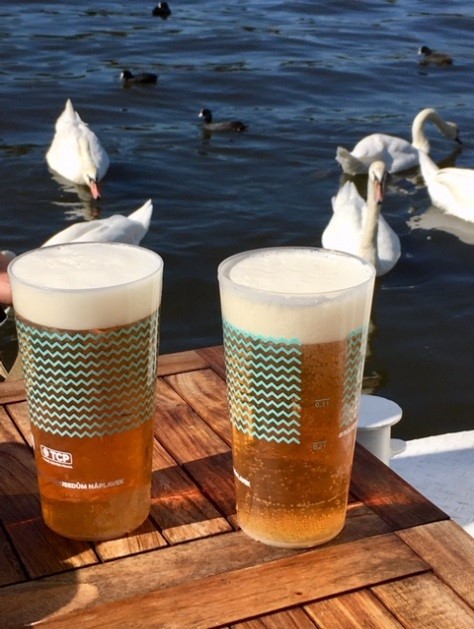


.png)






